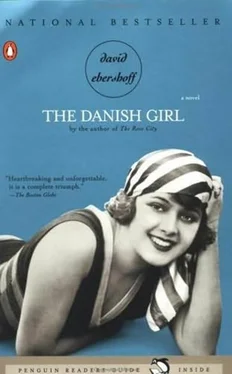“Martine-Martine!” called the governess. Martine’s buckle shoes ground through the gravel. One year, Einar told himself. And then again, from over her shoulder, Martine called cheerfully, “Merci.” She waved, and Einar and Lili as one waved in return.

After three years in Paris, Greta had never worked harder in her life. In the mornings, when Lili was out doing the marketing or bathing at the pool, Greta would complete her magazine assignments. There was an editor at La Vie Parisienne who called nearly every week, panic in his fussy voice, asking for a quick drawing of the opera’s latest production of Carmen , or a sketch to accompany the story on the exhibition of dinosaur bones at the Grand Palais. Really, there was no need to accept such a job, Greta would tell herself. Her name had been appearing in the magazines for a couple of years; but on the telephone the editor would squeak about his need for artwork. As Greta, the phone receiver between her chin and shoulder, watched Lili slip out of the apartment, Greta would think to herself, Oh, why not? Yes, she would do the sketch. Yes, she could deliver it by the morning. But I really must be getting to it, Greta would say, replacing the receiver in its cradle and then going to the window to see Lili, quick in the daylight, off to the Marché Buci, her pink spring coat bright against the dull, rain-soaked street.
Not until Lili returned would Greta’s real work begin. Then she would boil a cup of tea for Lili and say, “Come sit here,” posing her on a stool, or next to a potted palm tree, placing the cup and saucer into Lili’s hands. No matter the weather, Lili would always return to the apartment cold, her hands trembling. Greta feared she didn’t have enough flesh on her frame, but she could never get her to eat anything more. The bleeding returned every now and then, once every few months, announced by a slow drop of blood inching across Lili’s upper lip. Then she would lie in bed for days, as if stored in those few crimson drops was all her energy. Greta had taken Einar to one or two French doctors, but as soon as they began to probe with their questions (“Is there anything else I should know about your husband?”), she would realize that none of them would have any more answers than Dr. Hexler. She would worry as Lili lay in bed, sleeping through the day, staining the sheets, which Greta would later have to shove into the incinerator behind the apartment. But then, after a few days, sometimes a week, just as quickly as it had begun, the bleeding would cease. “How dull it is to spend a week in bed,” Lili would say, throwing the bolster pillow to the carpet.
If she were to count them up, Greta would discover that she had more than one hundred paintings of Lili by now: Lili bathing in the pool; Lili as a member of a wedding party; Lili examining carrots at the market. But most were Lili set in landscapes, on a heath, in an olive grove, against the blue line of the Kattegat Sea. Always her eyes brown and huge, hooded; the delicate curve of her plucked eyebrows; hair parted around the ear to reveal an amber earring hanging against her neck.
Einar himself no longer painted. “I’m having a hard time imagining the bog,” he’d call from his studio, where his canvases and his paints were kept tidy. Out of habit he continued to order bottles of paint from Munich, even though the best paints in the world were sold just across the river at Sennelier, where the clerk kept a perpetually pregnant cat. Greta hated the cat, whose bloated stomach sagged to the floor, but she enjoyed visiting with the clerk, a man named Du Brul, who often said, with his Van Dyke goatee twitching madly, that she was his most important lady customer. “And some believe a lady cannot paint!” he ’d say as she left the store with a box of paint bottles wrapped in newsprint, the cat hissing as if she were about to give birth.
The apartment on the rue Vieille du Temple had a central room big enough for a long table and two reading chairs by the gas fireplace. There was a red velvet ottoman in the room, large and round, with an upholstered column rising from its center, like the kind in shoe stores. And an oak rocker, with a brown leather cushion, shipped over from Pasadena. She had begun to call the apartment the casita. It didn’t look like a casita, with its split-beam ceilings and the portes-fenêtres with their copper lock-bolts separating the rooms. But for some reason it made her think of the casita on the rim of the Arroyo Seco she and Teddy Cross had moved into after they left Bakersfield. The sunlight that poured in from the mossy brick patio had helped Teddy rise every day with another idea for a pot to throw on his wheel, or two colors to combine for a glaze. He had worked quickly and freely when they lived there. There was an avocado tree in the back garden that produced more heavy green grenades of fruit than they could possibly eat or give away. “I want to be like the avocado tree,” Teddy would say. “Constantly producing.” Now in Paris, in the casita, Greta thought of herself as the avocado tree. From the branch of her filbert brush the Lili paintings continued to drop and drop and drop.
For a while she regretted Einar’s abandoned career. Many of his landscapes hung in the apartment, crown molding to baseboard. They were a constant and sometimes sad reminder of their inverted lives. At least to Greta. Never did Einar admit that he missed his artist’s life. But she sometimes missed it for him, finding it hard to understand how one who had spent his life creating could simply stop. She supposed his old drive-the need to turn to a blank canvas with a chestful of ideas and fear-was now transferred to Lili.
Within a year of their arrival in Paris, Hans had begun to sell the Lili paintings. With the magazines calling, Greta’s name began to float around Paris, in the cafés along boulevard St-Germain, in the salons where artists and writers lay on zebra-skin rugs drinking distilled liqueurs made from yellow plums. So many Americans in Paris, too, each talking about the other, eyeing one another in that American way. Greta tried to stay clear of them, of the circle that gathered nightly at 27 rue de Fleurus. She remained suspicious of them, and they of her, she knew. Their nights of fireside gossip about who was or wasn’t modern didn’t interest Greta. And in those societies of wit and airs, Greta knew, there was no room for Lili or Einar.
But the demand for the Lili paintings continued, and just as Greta began to feel as if she couldn’t keep up, she had an idea. She was painting Lili in a field of lucerne grass in rural Denmark. To do this she had Lili stand in her studio with her fists on her hips. The portrait of Lili Greta managed easily enough, although she had to imagine the flat Danish summer sunlight on Lili’s face. But the background of the field, with the grass rising behind Lili, didn’t interest Greta very much. To paint the grass properly, and the distant kettle-hole lakes, would take Greta several days; first the horizon would have to dry, then the lakes, then the first layer of grass, then a second and a third.
“Would you like to finish this one up for me?” Greta asked Einar one day. It was May 1929, and Einar had been out the whole afternoon. He returned to the apartment saying he’d spent the afternoon in the place des Vosges, “Watching the children fly their kites.” He looked especially thin in his tweed suit, his coat over his arm. “Is everything all right?” she asked as he loosened his tie and went to make himself a cup of tea. In his shoulders Greta saw a sadness, a new melancholy blacker than anything she had seen before; they hung like a frown. His hand sat cold and lifeless in hers. “I’m having a hard time keeping up. Why don’t you start doing some of my backgrounds? You know better than me what a field of lucerne grass should look like.”
Читать дальше













